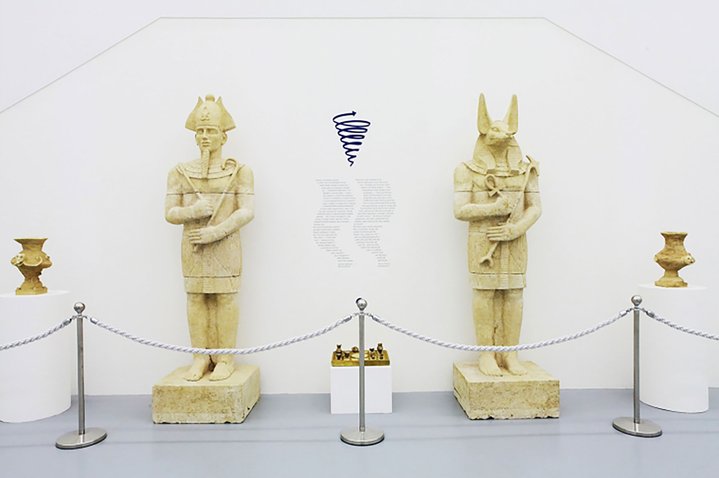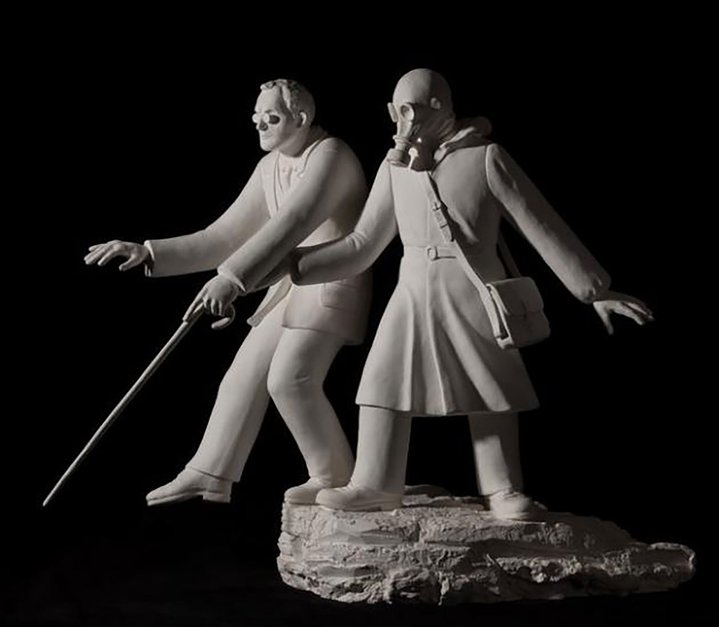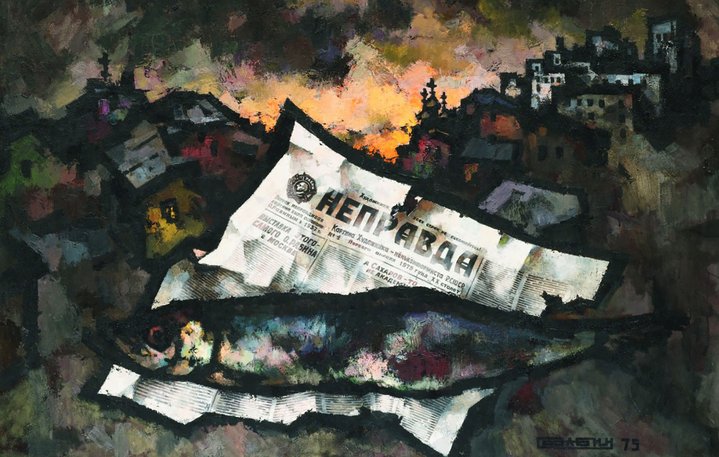Does the winner take it all?

In Russia, there is not one, but two prized awards for artists to recognise special achievement in the visual arts, the Innovation and Kandinsky prizes, as well as a host of newer awards for younger contemporary artists. Can these awards bring about a rise in the market value of an artist?
Russian artist Evgeny Antufiev (b. 1986) shares his feelings about art prizes: they bring increased confidence in one’s work and act as a motivating force, but there is always the trauma of sitting among friends and rivals at an award ceremony waiting to be called out — or not. As a nominee, he has been on both sides, but he recently won the coveted Kandinsky Prize in 2019 for his project ‘When Art Became Part of Landscape’, and following a win in the young artist category a decade before, IS the only artist to have won the accolade more than once.
In recent times, artists have not had to endure such public trials. There has been a turnabout, a rejection of the traditional “one person grabs the prize” scenario. Not only due to the global pandemic; there has been a global shift towards a sense of increased social equality in the arts, which has come to roost in the world of gilded prizes. In the UK, all four Turner prize nominees on the shortlist clubbed together two years ago, subverting the judging process with a request to share the prize, because they all felt it was unfair to judge one above the other with such diverse backgrounds and art practices. The jury agreed, seeing it as a bold statement of solidarity reflecting “the political and social poetics we admire and value in their work”.
In Russia last year, all five artists shortlisted for the Innovation ‘best work of art’ prize were declared joint winners by Jean-Hubert Martin, who represented the jury. All the other prize categories followed suit and some felt it was going too far. However, if you believe that winning is more important than participation, then listen up: a published study on the Turner Prize then in its thirtieth year (Penet and Lee, 2014) showed resoundingly that when it comes to market value, it is not only the winner, but also the nominees who experience a boost to their auction value. It is, what one might call a win-win situation.
Yet, in Russia, if one can talk of a market upturn directly connected with winning or being nominated for one of the national art prizes, barely into their second decade of existence, the picture is more mixed. It is difficult to establish a clear link between increased market prices and the occasion of winning a prize. There are numerous other variables that can affect market value, from a particularly strong group of works coming onto the market in any one auction or season which pique the interests of top collectors, to the artist having a solo show at a major international museum. For artists working in video, digital or photographic media, we cannot talk of any positive market effects, since traditional auction does not favour these media and there are few public results. And even for the conceptualist giant Andrei Monastyrski (b.1949), his win of the Innovation Prize in 2015 did not bring any increased interest on the auction market, as his work is often more suited to museum collections. A scenario of course equally evident in the West as in Russia.
Researching this topic, I picked out ten contemporary Russian artists, all of whom work in media, which traditionally sells well on the art market (such as painting, drawing or sculpture) to compare sales volumes before, during and after they won a prize. They had to have either received one of three awards: Innovation’s Artist of the Year prize, the Kandinsky Prize’s Project of the Year, or the highly coveted Innovation Creative Contribution (lifetime achievement) award. Similar to the MacArthur Fellows programme in the USA, the recipients of the latter are selected by the judges without the process of a competition.
Reviewing the results, there emerged the sense that the more established the artist already was, the stronger the market performed in the year they won the award and the year after. So, it bore out the suggestion that there could indeed be a market boost effect for those artists. The market for both Ilya Kabakov (b. 1933) and Erik Bulatov (b. 1933) showed a strong upswing in the same year they received the top Innovation award, in 2011 and 2013 respectively. In the case of Ilya and Emilia Kabakov, they had no major museum exhibition around that time which could otherwise explain strong market growth; Bulatov’s big show at the Manege in Moscow was in 2014.
Among artists whose sales jumped the year after they won one of the top two prizes are Boris Orlov (b. 1941) and Pavel Pepperstein (b. 1966). Oscar Rabin (1928--2018) also followed a similar pattern, yet his market growth also coincided with the peak of the wider art market boom in 2007, so it is hard not to see this as the main driver of the dynamic. Further, the Innovation prize had only just been established, it was too new to have resonance with the public. Perhaps, it is only now into their second decade that these Russian art prizes can begin to bestow upon their laureates the added public promotion that might translate into raised value on the commercial market. It took the Turner Prize a decade before it appeared to have any strong correlation with artist price growth, the prizes themselves need time to establish their currency.
It also happens that owners of art themselves believe the added exposure of an art prize win could bring them a better result, if they time a sale alongside an event such as a prize win. This can bring more works onto the market than normal creating a double positive. But, although this could be said to apply to Kabakov, where we saw a 44% increase in works sold in his prize year, and Bulatov, whose sales value trebled, it does not stand up against scrutiny when looking at other artists, such as Grisha Bruskin (b. 1945), who won the Kandinsky Prize in 2012 a year when there were no works by him sold on the international market at all. In 2009, Vadim Zakharov (b. 1959) won the Kandinsky Prize in its third edition, after a few years of good auction results, but that year, he had no auction sales either and, the following year, an important four-piece Soviet era work, ‘Reproductions’, which had been priced conservatively remained unsold at Phillips. If anything is clear it is that it is challenging to draw hard and fast conclusions. One of the obstacles for Russian contemporary artists is visibility, not only at home, but abroad in the West. In Russia, there is not one, but two main prizes competing for attention, the state-run Innovation prize and the Kandinsky prize established by entrepreneur and art philanthropist Shalva Breus in 2007. Unlike the Turner or the Duchamp prize, which are only given to one artist per year, both Russian prizes have numerous categories and are also not exclusively given to artists. It’s a democratic and inclusive approach, rewarding talent and achievement in the arts recognising that artists do not create alone and the huge infrastructure around them is equally deserving of public merit. But that sense of creative genius that the Turner prize confers upon its nominees and winners who belong to an exclusive artistic community is rarefied. It might be that with artist prizes, sometimes less is more.
On the subject of international visibility for award winners, the Russian prizes are still relatively new kids on the block and struggle to get as much attention in international media as comparative awards in the West, a situation the organisers are working hard to change, says Yuri Albert (b. 1959) former prize winner. Even so, he notes: “When someone gets the Turner prize, both the Russian and international press write about it. If someone wins the Kandinsky or Innovation Prizes, then you only read about it in the Russian press.”
The Turner Prize and France’s Marcel Duchamp Prize both involve not only a monetary award and the kudos that comes with it, but the artist also gets to show their work in a world class museum, in this case among the most highly visited museums in the world: the Tate and the Pompidou Centre. In the end, this institutional exposure in itself may prove to be more important than being named prize winner, as Antufiev says: “Prizes have little influence on market value. Much more important is having your work acquired by museums and taking part in museum exhibitions.
”Finally, perhaps we can spare a thought for Russian contemporary grandees. The Innovation lifetime award celebrates artists from older generations, looking back over a career well-trodden, such as Oscar Rabin, who was in his 80th year when he won it – until recently, the Turner prize only accepted artists under the age of 50. When the Kabakovs earned the lifetime award in 2011, it was only after they had hastily withdrawn from the competition shortlist for the best work of art category a year before, as people felt they had an unfair advantage over less established artists a fair point. But a balance must be found between the generations and in Russia there is some catching up to do. What we refer to as contemporary art is generally accepted to begin somewhere around the 1960s, three score years ago. Artist awards are normally given to living artists only, a rule which was overridden once in Russia in 2008 for Moscow conceptualist Dmitry Prigov (1940–2007). He had passed away the year before the Innovation’s lifetime achievement award was given in his honour. Due to the legacy of the old soviet system, there is a raft of contemporary artists waiting in the wings who have not had the benefit of any award. Many of these have already passed away, such as Dmitry Plavinsky (1937–2012), Lydia Masterkova (1927–2008), Oleg Vassiliev (1931–2013), Leonid Sokov (1941–2018) and Ivan Chuikov (1935–2020) to name only a few. Although history cannot be rewritten, perhaps there could be a way of recognising their contributions to Russian visual culture in the form an award given retrospectively.










